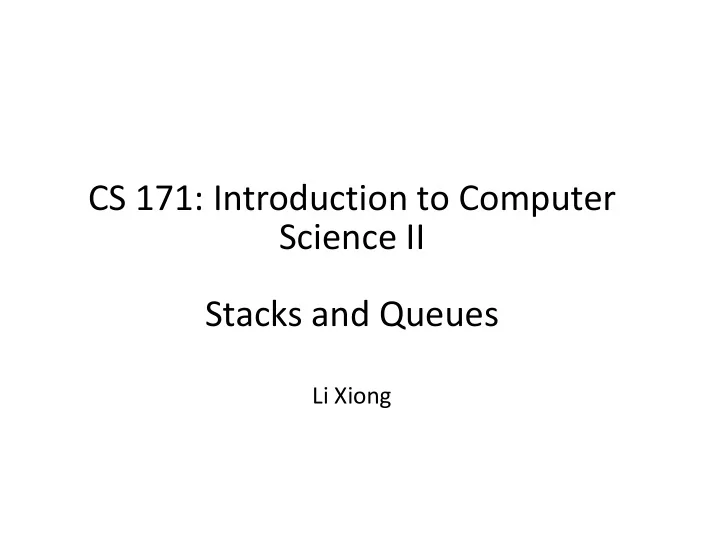

CS 171: Introduction to Computer Science II Stacks and Queues Li Xiong
Roadmap � Java basics � OO and inheritance � Arrays and ArrayList � Abstract data types Abstract data types � Stacks � Queues � Algorithm analysis
Abstract Data Types � Data type � A data type is a set of values and a set of operations on those values � Abstract data type (ADT) � Abstract data type (ADT) � An abstract data type is a data type whose internal representation is hidden from the client
Implementing and using ADTs � ADTs are implemented in Java as classes � Instance variables are private (hidden from the client) � Instance methods may be public (specified in the API) or private (organize the computation and hidden from the client) � Application programming interface (API) � specifies the behavior of an ADT including constructors and instance methods � Using ADTs � Create objects of implemented ADTs � Invoke instance methods to operate on data-type values
Examples of Java ADTs � Standard system ADTs � Integer, Double, String, StringBuilder … � Data oriented ADTs – facilitate organizing and processing data processing data � Point2D, Interval1D, Date, … � Collection ADTs – facilitate organizing and manipulating collections of data � Stack, Queue, Priority Queue, …
Collection Abstract Data Types � Stacks and queues � API - intended behavior � Implementation – how to implement Implementation – how to implement � Applications - how to use
Stacks � A stack stores an array of elements but with only two main operations: Push : add an element to the top of the stack Pop : remove the top element of the stack. Pop : remove the top element of the stack. � Pop always removes the last element that’s added to the stack. This is called LIFO (Last- In-First-Out).
Stacks – A Familiar Example � A can of tennis balls � Imagine the entire can represents an array, and each ball is an element. � It only allows access to one element at a time: the last element. the last element. � If you remove the last element, you can then access the next-to-last element. � There is no way to directly access the element at the bottom.
Stacks – Another Example � A dynamic list of tasks you perform everyday: � Imagine you start your day by working on task A. � At any time you may be interrupted by a co- worker asking you for temporary help on task B. � While you work on B, someone may interrupt While you work on B, someone may interrupt you again for help on task C. � When you are done with C, you will resume working on B. � Then you go back to work on A. � Think about the sequence of tasks you perform.
Stacks – Any other examples?
Stack Examples
Stacks � An element cannot be inserted to or accessed from the middle of the array. � The only way you modify the elements is through the push and pop operations. � This capability turns out to be very useful in many programming situations. � In a computer, the stack is an essential data structure for handling program calls and returns.
Stacks � Programmer’s tool � Arrays are typically used as data storage structures in apps such as a database (e.g. personal records, inventories …) � In contrast, stacks are often used as � In contrast, stacks are often used as programmer’s tool, and are not typically used for data storage.
Stack: Array implementation � Underflow: what happens if pop from an empty stack? � Throw exception � Overflow: what happens if push to a full � Overflow: what happens if push to a full stack? � Use resizing array
Recommend
More recommend